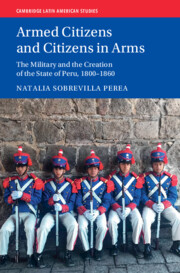Refine search
Actions for selected content:
220 results
“Slavery-Free”: Labour at the Todos os Santos Factory (Bahia, ca. 1840–1870)
-
- Journal:
- Itinerario , First View
- Published online by Cambridge University Press:
- 24 September 2025, pp. 1-21
-
- Article
-
- You have access
- Open access
- HTML
- Export citation

Armed Citizens and Citizens in Arms
- The Military and the Creation of the State of Peru, 1800‒1860
-
- Published online:
- 12 September 2025
- Print publication:
- 25 September 2025
Translating French mathematics and lobbying the horse-drawn carriage trade (USA, 1869–1877)
-
- Journal:
- Science in Context , First View
- Published online by Cambridge University Press:
- 08 September 2025, pp. 1-26
-
- Article
- Export citation
A Genre in Flux: Grand opéra Through the Lens of French Touring Companies, 1830–1860
-
- Journal:
- Cambridge Opera Journal , First View
- Published online by Cambridge University Press:
- 01 September 2025, pp. 1-24
-
- Article
-
- You have access
- Open access
- HTML
- Export citation
5 - Individual Rights under International Law
-
- Book:
- People v. The Court
- Published online:
- 07 August 2025
- Print publication:
- 21 August 2025, pp 113-134
-
- Chapter
- Export citation
From Past to Future
-
- Book:
- Democracy's Double Helix
- Published online:
- 09 September 2025
- Print publication:
- 14 August 2025, pp 288-306
-
- Chapter
- Export citation
Introduction
-
- Book:
- The Birth of Democracy in South America
- Published online:
- 04 June 2025
- Print publication:
- 07 August 2025, pp 1-16
-
- Chapter
-
- You have access
- Open access
- HTML
- Export citation
2 - Elections and Democracy in South America before 1930
-
- Book:
- The Birth of Democracy in South America
- Published online:
- 04 June 2025
- Print publication:
- 07 August 2025, pp 48-73
-
- Chapter
-
- You have access
- Open access
- HTML
- Export citation
4 - The Origins of Strong Parties in South America
-
- Book:
- The Birth of Democracy in South America
- Published online:
- 04 June 2025
- Print publication:
- 07 August 2025, pp 98-122
-
- Chapter
-
- You have access
- Open access
- HTML
- Export citation
5 - The Roots of Strong Democracies
-
- Book:
- The Birth of Democracy in South America
- Published online:
- 04 June 2025
- Print publication:
- 07 August 2025, pp 123-174
-
- Chapter
-
- You have access
- Open access
- HTML
- Export citation
1 - Armies, Parties, and the Birth of Democracy
-
- Book:
- The Birth of Democracy in South America
- Published online:
- 04 June 2025
- Print publication:
- 07 August 2025, pp 17-47
-
- Chapter
-
- You have access
- Open access
- HTML
- Export citation
8 - The Roots of Unstable Authoritarianism
-
- Book:
- The Birth of Democracy in South America
- Published online:
- 04 June 2025
- Print publication:
- 07 August 2025, pp 262-301
-
- Chapter
-
- You have access
- Open access
- HTML
- Export citation
6 - The Roots of Weak Democracies
-
- Book:
- The Birth of Democracy in South America
- Published online:
- 04 June 2025
- Print publication:
- 07 August 2025, pp 175-223
-
- Chapter
-
- You have access
- Open access
- HTML
- Export citation
7 - The Roots of Stable Authoritarianism
-
- Book:
- The Birth of Democracy in South America
- Published online:
- 04 June 2025
- Print publication:
- 07 August 2025, pp 224-261
-
- Chapter
-
- You have access
- Open access
- HTML
- Export citation
3 - Military Professionalization and the Decline of Revolts in South America
-
- Book:
- The Birth of Democracy in South America
- Published online:
- 04 June 2025
- Print publication:
- 07 August 2025, pp 74-97
-
- Chapter
-
- You have access
- Open access
- HTML
- Export citation
Conclusion
-
- Book:
- The Birth of Democracy in South America
- Published online:
- 04 June 2025
- Print publication:
- 07 August 2025, pp 302-316
-
- Chapter
-
- You have access
- Open access
- HTML
- Export citation
Chapter 15 - The Strange Case of a “Lost” Dramatic Performance
- from Part IV - Transcreating
-
-
- Book:
- Latinx Literature in Transition, 1444–1886
- Published online:
- 06 August 2025
- Print publication:
- 17 July 2025, pp 341-362
-
- Chapter
- Export citation
Chapter 8 - “Tragic Time”
- from Part II - Transcending
-
-
- Book:
- Latinx Literature in Transition, 1444–1886
- Published online:
- 06 August 2025
- Print publication:
- 17 July 2025, pp 190-206
-
- Chapter
- Export citation
3 - Catholicism and the Italian Welfare State in the Nineteenth Century
-
- Book:
- How Economic Ideas Evolve
- Published online:
- 06 June 2025
- Print publication:
- 10 July 2025, pp 66-95
-
- Chapter
- Export citation
2 - Catholicism and the Formation of the German Welfare State
-
- Book:
- How Economic Ideas Evolve
- Published online:
- 06 June 2025
- Print publication:
- 10 July 2025, pp 28-65
-
- Chapter
- Export citation
